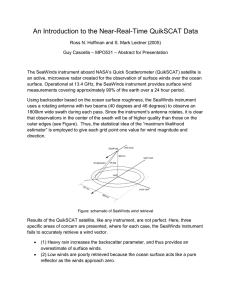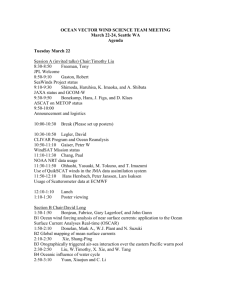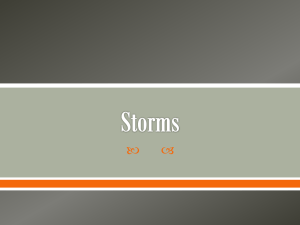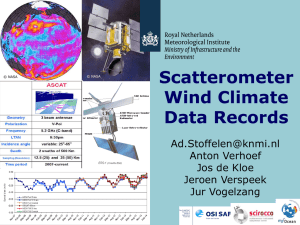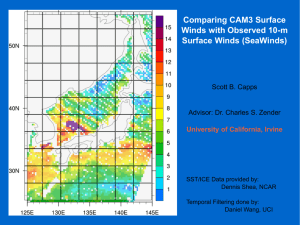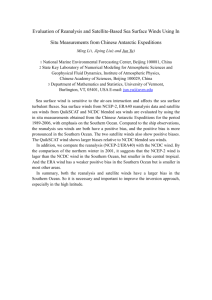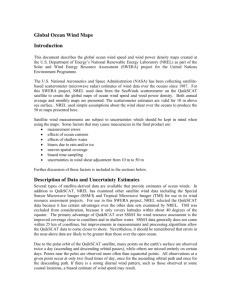The Post QuikSCAT ERA Paul Chang and Zorana Jelenak NOAA/NESDIS August 10, 2010
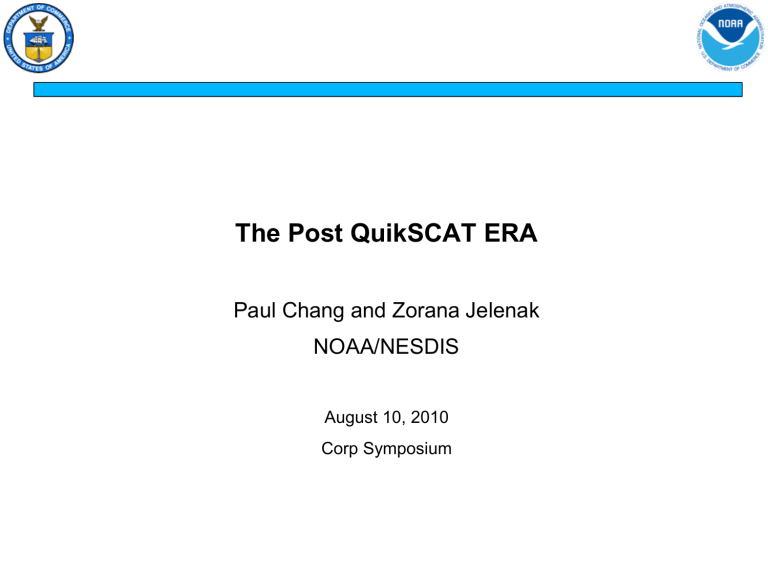
The Post QuikSCAT ERA
Paul Chang and Zorana Jelenak
NOAA/NESDIS
August 10, 2010
Corp Symposium
Outline
QuikSCAT impacts
QuikSCAT decade-long OSVW record
Post QuikSCAT mitigation efforts
Outlook
Benefits Gained from QuikSCAT at National Hurricane Center
Increased surface wind data for all three major analysis parameters
Intensity (Maximum sustained 1-min 10-m wind)
Center Fixing/Identification (short term motion and model initialization, initiation and discontinuation of advisories)
Structure (34-, 50-, and 64-kt wind radii)
Arctic Support Services
Support to the USCG Hamilton on Arctic Mission Sep 2008
• Ocean surface vector winds and sea ice
• extent and characterization
• In support of maritime commerce
• and resource exploitation
NOAA Ocean Prediction Center –
Impact on Operations
QuikSCAT
Forecasters used every pass to: make warning and short-term forecast decisions and to estimate
- cyclone location, intensity, extent of wind field
- strength and extent of orographically enhanced jets
- wind field near strong SST gradients
Resulted in improved warning and forecast services over otherwise data sparse oceans
Extratropical Cyclones with Hurricane Force Winds
Detected using QuikSCAT
70
60
WARNING
CATEGORIES
Pre- QSCAT
1. GALE 34-47 kt
2. STORM >48
QSCAT ERA
1. GALE 34-47 kt
2. STORM 48 -63 kt
3. HURCN FORCE
> 64 kt l o
C y c n e s
50
40
30
20
10
•
Hurricane Force Warning Initiated Dec 2000
•
Detection increased with
-
Forecaster familiarity
-
Data availability
Improved wind
algorithm and
rain flag Oct 06
-
Improved resolution
-
Improved algorithm
12.5 km QuikSCAT
available May 04
25 km QuikSCAT
Available in N-AWIPS
Oct 01
37
33 31
34
64
51
43
48
Hurricane Force
Wind Warning
Initiated Dec 00
23
24 23
22
QuikSCAT
Launch
Jun 99
11
9
14
15
0
1997-
98
1998-
99
1999-
00
2000-
01
2001-
02
2002-
03
2003-
04
2004-
05
2005-
06
2006-
07
2007-
08
Atlantic
Pacific
Extreme winter ocean storms occur over major shipping routes: North Atlantic example
Major Shipping Routes
North Atlantic
4,000/yr container transits
1,000/yr bulkers
The geographic distribution of all cyclone centers that contained hurricane force conditions for the
North Atlantic basin 2001 - 2008
Geographic distribution of cyclones with winds of HF intensity
7
Sep-May 2000-2007
Cumulative number of extratropical cyclones observed (contoured) with hurricane force winds for the years 2000 - 2007
Hurricane Force Winds Occur Across the Sea Lanes
~ 6,000 Containership transits/year
Operating costs - $50,000 per day
~1,500 Dry bulk transits/year
Operating costs - $20,000 per day
Major Shipping Routes
North Pacific
Impact on Maritime Commerce
Present level of warning/forecast services to 48 hours w/QuikSCAT
$135 million per year savings in reduced damage / cargo loss for container and bulk commerce (Kite-
Powell, 2008)
Kite-Powell, Hauke, 2008: Benefits to Maritime Commerce from Ocean Surface Vector Wind Observations and Forecasts, Maritime Economics and Logistics (in review), pp. 15. Available online at: http://manati.orbit.nesdis.noaa.gov/SVW_nextgen/QuikSCAT_maritime_report_final.pdf
Millersville University, Nov 12, 2009
QuikSCAT Hurricane Force Extratropical
Cyclones Observations - Summary
QuikSCAT – Hurricane Force Winds in extratropical cyclones more frequent than thought
Predominantly cold season phenomena
Onset, rapidly deepening phase
Ocean phenomena but…
landfall AK, PAC NW, Europe, even East Coast
Conditions impact coastline without landfall
Climiatology of Hurricane Force
Extratropical Cyclones
Utilize decade long QuikSCAT OSVW record to study frequency and characteristics of these extreme events
HF Cyclone Database
Storm ID
Date
Lat
Lon
.
Press
Type
PAC011007 2007100712 43.93 -169.72
1013 L
PAC011007 2007100718 43.23 -164.06
PAC011008 2007100800 42.37 -158.38
PAC011008 2007100806 41.33 -152.07
PAC011008 2007100812 39.87 -143.82
PAC011008 2007100818 40.76 -137.83
PAC011009 2007100900 43.15 -134.94
PAC011009 2007100906 44.46 -134.08
PAC011009 2007100912 46.45 -132.94
PAC011009 2007100918 47.51 -132.81
PAC011010 2007101000 48.90 -132.36
PAC011010 2007101006 50.65
-132.3
PAC011010 2007101012 52.17 -132.36
PAC011010 2007101018 53.67 -131.68
1010 G
1010 G
1007 G
998
974
970 H
964 H
966 H
968 H
967 S
S
S
964 S
975 G
977 G
Estimate cyclone motion speed and direction
Extract all hurricane force 6-h cycles per month
Extract hurricane force events during 6h, 12h 18h, 24h and >24h
Perform statistical analysis of these events
Select QuikSCAT files that correspond to each chosen event
Cyclone Motion Speed and Direction during HF cycles
Mean~
50 °
Fast moving cyclones with average storm speed ~25kts
Storm moving in NE direction (average heading 50 °) during hurricane force wind phases
Number of HF Cyclones per Month
2001-2008 North Pacific
No of HF Cyclones No of 6h HF Cycles
250
200
150
100
50
0
Sep Oct Nov Dec Jan Feb Mar Apr
Extratropical cyclone season from September to April
Peak activity during December and January
September and April have same number of cyclones, but April storms last longer
Duration of HF Events
25
20
15
10
5
0
6h 12h 18h 24h 30h 36h 42h 48h 54h
HF Event Duration
Most HF events last between 6-24h
50% of 12-h events occurred during December
75% of 30-h events occurred during November and December
In February most events last between 18-24h
Mean Cyclone Wind Speed
2001-2008 North Pacific
3000km
2000km
Storm motion direction
1000km
Wind Force Frequencies
Hurricane Force > 64kts Storm Force Wind >48kts
Gale Force >32kts
W
October
N
E
November
S
January
February
December
March
300
250
200
150
100
50
0
0-6h 6-12h 12-18h 18-24h >24h
12-
18h
0-6h
18-
24h
6-
12h
>24h
QuikSCAT decade-long OSVW record
Impact of the changing wind on evaporation
perspective from the OAFlux 50-year time series
Trend in global E
Effect of Wind (U)
Effect of humidity ( q)
Courtesy L. Yu, WHOI, 2009
Coherent Changes in E and Wind: tropical oceans
Courtesy L. Yu, WHOI, 2009
Ocean Circulation and
Climate Change
Can satellite winds and an ocean model be used to predict northern hemisphere Tropical cyclone activity a year in advance?
Global sea level rise is due to two components:
– fluxes of water into the oceans, and
– steric sea level rise due to heat induced expansion of the ocean’s volume.
• Wind forcing modifies the ocean’s circulation, modifying the pattern of steric sea level rise.
• The observation of the modulation of large-scale ocean sea level by winds has been enabled by the availability of a decade long scatterometer wind data record.
Graphics from Maue, R. N., 2009: Northern Hemisphere Tropical Cyclone Activity. Geophys. Res. Lett., 36
Gas Fluxes into the Ocean
0.8
0.6
0.4
0.2
0
1.4
1.2
1
•
A key unknown in predicting global climate change is the rate of uptake by the oceans of greenhouse gases
– Oceans constitute their primary sink (for the moment).
– Winds are the primary uncertainty in the determination of the gas transfer coefficient for CO
2
( Gary Wick , personal communication, 2008)
– Long term changes in wind appear to be correlated to changes in evaporation ( Yu et al . 2007, 2009)
• Water vapor is the key greenhouse gas
• A longer time series based on better inter calibrated data is needed
COARE-only, no bubble
GasEx-98
GasEx-01
SO-GasEx
Sensitivity analysis of errors in
CO2 transfer velocity
Far more sensitive to errors in wind than other input variables
Graphic courtesy Gary Wick
ALL Ws SST Ta Qa Rl Rs
Mitigation Efforts
ASCAT Measurements Geometry
Top view
Can ASCAT high wind speed retrievals be improved?
200
180
160
140
120
100
80
60
40
20
0
QSCAT-Hi
Hurricane Force Observations
Oct’07 ~ May’08
195
168
• Loss of QuikSCAT data could possibly result in 80-
90% reduction in detection of hurricane force winds
• Necessary to investigate improvement in ASCAT wind retrievals to try better support wind warning and forecast products for extreme winter ocean storms
QSCAT-p ASCAT
2
GFS
38
ECMWF
4
15
Surf. Obs.
•
ASCAT underestimate high wind speeds in comparison to
QuikSCAT
•
Hurricane force wind detection from
ASCAT is very rare
Measured and Model Sigma0 dependence on wind vector at 30 deg incidence
ASCAT/QuikSCAT match-ups @ 30 ° incidence
5m/s
9m/s
12m/s
CMOD5n B
0
15m/s
17m/s
Relative wind direction (Degree)
“True” B
0
20m/s
CMOD5n vs New B
0
CMOD5n B
0
New B
0
Wind Speed (m/s)
ASCAT vs QuikSCAT speed (before)
Cumulative
distribution
curve
ASCAT vs QuikSCAT speed (after)
Cumulative
distribution
curve
Across Swath Speed Biases (before)
2 m/s reference line
Across Swath Speed Biases (after)
2 m/s reference line
Across Swath Speed RMS errors (before)
2 m/s reference line
Across Swath Speed RMS errors (after)
2 m/s reference line
Hurricane Force Observations
( Oct’07 ~ May’08 )
250
200
150
100
212
188
50
2
39
38
19
0
QS -12.5 km QS - 25 km AS - opr AS - new GFS OBS
North Atlantic Extratropical Storm Example
Operational ASCAT
New ASCAT
Operational ASCAT wind product detects
STORM force wind.
One wind warning category lower than the actual winds.
QuikSCAT & New
ASCAT wind products detects HF wind.
QuikSCAT
Operational
ASCAT
Sonde Wind Speed
28.8m/s
SFMR 28 m/s
ASCAT 22 m/s
New
ASCAT
Sonde Wind Speed
28.8m/s
SFMR 28m/s
New ASCAT 25m/s
Outlook
QuikSCAT and DFS Scatterometer Designs
~2m
~1m
Ku-band
HH
VV
41
Ku-band+ C-band
HH
VV
DFS vs QuikSCAT Errors
Simulated Katrina QuikSCAT Performance
Measuring winds or rain?
SeaWinds Scatterometer
Surface Winds
Weather Research and Forecasting
Model (WRF) Surface Wind “Truth”
Weather Research and Forecasting
Model (WRF) Rain Rate “Truth”
DFS vs. QuikSCAT
Simulated Retrievals based on Katrina (2005)
QuikSCA
T t
54k t
64k
“Truth
” t
54k
t
64k
DFS t
54k t
64k
T
S
•
DFS better captures true wind signal where QuikSCAT high winds are tied to rain
•
DFS accurately depicts hurricane-force wind radii and retrieves winds into cat 2 range
•
DFS cannot identify small scale wind maxima
DFS vs. QuikSCAT and XOWVM
Katrina Simulated Retrievals
DFS
QuikSCAT
•
At high wind speeds, the dual frequency scatterometer can improve performance up to 50%
•
The resolution of the phenomena measured is higher than resolution of DFS measurements therefore
• highest winds in TC’s can not be resolved
It is expected that DFS can provide wind speeds up to category 2 hurricane
Summary
QuikSCAT OSVW had tremendous benefits to operational weather forecasting and warning
Data from a research satellite was succesfully transition to operational utilization
The importance of satellite OSVW to climate monitoring and prediction is evident
Characterization of the important air-sea interface
Monitoring of extreme events
ASCAT can only partially mitigate the loss of QuikSCAT
NOAA is pursuing a QuikSCAT follow-on mission working the JAXA and
NASA/JPL (Dual-Frequency Scatterometer)
Effort is ongoing but still far from certain
The U.S. does not have a well defined process by which to objectively identify and transition required core satellite observing system capabilities from research to sustained operations
backup
Courtesy of Prof Mark
Bourassa FSU
Near coherent decadal variability in the Indo-Pacific region captured by
QuikSCAT & ERS scatterometers & altimeter data: opposite trends before & after year 2000
Decadal tendencies in the 1990s & 2000s are opposite in sign in much of the Indo-Pacific domain for wind ( ERS and QSCAT ) and sea level (T/P and J1). The wind patterns explains the sea level pattern
(through local Ekman pumping and westward propagation of Rossby waves.
They have strong implications to ocean circulation and heat transport, and highlight the oceanic and atmospheric teleconnection in the Indo-
Pacific region.
Lee & McPhaden
(2008), GRL.
Comparison of
QuikSCAT and Drift-
Age Model
Large reduction of
perennial sea ice
between years
2005-2007.
Red line represents the bound-
ary of perennial ice from the
the Drift-Age Model (>1 year)
NASA QuikSCAT scatterometer
Nghiem, Rigor, Perovich, Clemete-
Colón, Weatherly, and Neumann,
GRL, 2007.
2007
March
1970-2000:
Decrease of 0.5x10
6 km 2 /decade.
In the decade
2000s
Rapid reduction of perennial sea ice suggested by the model and verified by QuikSCAT data.
Decrease of 1.5x10
6 km 2 /decade, triple that in 1970-2000.
Climate Monitoring
Scatterometer OSVW measurements directly supports climate research and services by providing measurements needed to document:
heat uptake, transport, and release by the ocean; ocean carbon sources and sinks
(ocean surface vector winds modulates air-sea exchanges of gases such as CO 2 ) and air-sea exchange of water and the ocean ’s overturning circulation
Study Approach
Scatterometer wind retrievals are dependent on Geophysical
Model Function (GMF) that relates backscatter to ocean surface wind fields
The ASCAT operational GMF (CMOD5n) is written in harmonic terms:
0
B
0
(
,
)
[ 1
B
1
(
,
) cos
B
2
(
,
) cos 2
]
1 .
6
Hersbach, et al., J. Geophys. Res. (2007)
Assumption is that B
1 and B
2 are modeled correctly.
ASCAT/QuikSCAT match-ups show B wind speeds
0 is biased high at high
C-Band V-Pol sigma0 dependence on wind speeds
Aircraft experiment
(IWRAP)
CMOD5n
IWRAP valid range
25-65 m/s
Mean Wind Speed Field
2007-2009 Winter Seasons - North Pacific
QuikSCAT
ASCA
T
Mean Wind Speed Field
2007-2009 Winter Seasons - North Pacific
QuikSCAT
NEW ASCAT
Mean Wind Speed Field
2007-2009 Winter Seasons - North Pacific
QuikSCAT
NEW ASCAT
QuikSCAT
Hurricane Force Wind
Frequency
Storm Force Wind
Frequency
Gale Force Wind
Frequency
ASCAT
Hurricane Force Wind
Frequency
Storm Force Wind
Frequency
Gale Force Wind
Frequency
QuikSCAT
Hurricane Force Wind
Frequency
Storm Force Wind
Frequency
Gale Force Wind
Frequency
NEW ASCAT
Hurricane Force Wind
Frequency
Storm Force Wind
Frequency
Gale Force Wind
Frequency
